Virtual PBX Poised to Replace Obsolete Telephone Systems

By Berge Ayvazian
Berge Ayvazian joined UBM Tech as a senior consultant on the Heavy Reading team in 2011, following more than 20 years as a senior telecom industry analyst and strategy consultant with Yankee Group, where he served as CEO, CRO, and CSO. Ayvazian has been a regular contributor of analyst notes, white papers, and webcasts for Light Reading, and he now contributes to the custom research, consulting, publishing, and conference programs through UBM Tech’s Create division. He conducts custom research and consulting projects on the convergence of broadband and mobility, cloud and enterprise applications and networks.
As the nature and location of work has changed over the past several years, organizations are increasingly seeking flexible communications that support in-office as well as remote employees (and those who move among multiple locations). Employees at organizations of all sizes have become increasingly dependent on communications systems to keep pace with the new mobile work style. The most successful companies will be those that leverage technology to empower their employees, removing obstacles to their success, and engage this new workforce in ways that will drive the business. New communications and collaboration tools are needed to effectively tie together and promote teamwork among dispersed workers.
Many companies, but particularly small and midsized businesses, are finding that their traditional phone systems aren’t reliable or flexible enough to meet these changing patterns of work and customer needs. As a result, many are seeking alternatives to PBX telephone systems that have become obsolete, expensive, and labor intensive to manage. Recent UBM Tech research, based on a survey of 228 IT directors, networking decision makers, and other senior management executives involved in purchasing telephone systems and unified communications services at small and midsized companies, revealed that a significant 59% of companies surveyed would consider a hosted or virtual alternative to traditional PBX or key systems (see Figure 1). That number isn’t surprising, given that Infonetics Research predicts that the number of seats for hosted business VoIP and unified communications services is on track to more than double between 2012 and 2016.
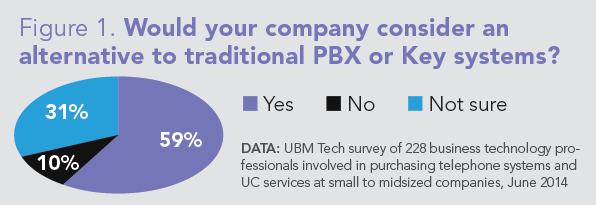
To date, SMBs with fewer than 500 employees have been the early adopters of cloud-based VoIP services. GrowthMark conducted a survey of more than 850 SMB owners and decision makers across North America in March and April 2013, which found that 20% of the SMBs surveyed were already using IP communications.
Companies that are considering the replacement of their current telephone systems are driven to do so by the age or obsolescence of their equipment, the costs associated with managing and maintaining that equipment, and the need for modern communications features (see Figure 2).
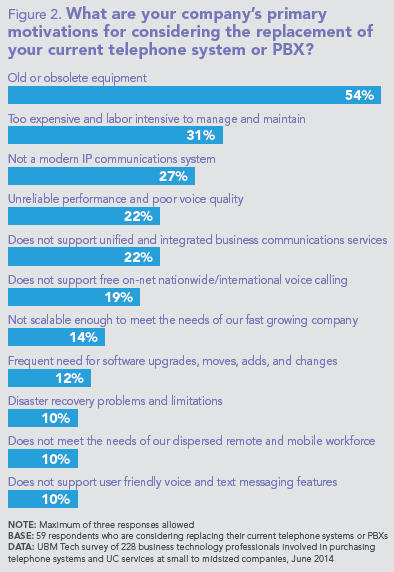
The research also found that many companies are reluctant to invest in a communications system with associated high maintenance costs and steep learning curves. Respondents who are considering replacing their current telephone systems say they are challenged to select a new IP-based PBX that will not become obsolete and unreliable in a few years (see Figure 3). After all, the rapid changes of the last five years quickly rendered their traditional PBX systems unable to support the anytime, anywhere communications necessary to support an increasingly mobile workforce.
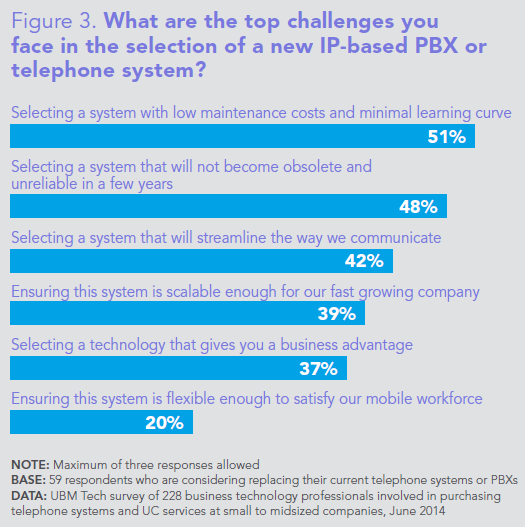
Cloud-based, hosted enterprise applications are clearly playing into organizations’ future strategies (see Figure 4). Currently 57% of the companies surveyed already use cloud-based business applications, and another 15% plan to use them in the future.
Cloud-based managed phone services provide a virtual PBX that offers features that are easy and intuitive to use and that help companies run a faster, more efficient business. Because everything is managed in the cloud, there is no need to make the major capital and hardware management investment that typically comes with traditional PBX phone systems. In addition to making it possible to minimize capital expenditures on expensive hardware, cloud-based phone services remove the need to hire staff to monitor the system. There’s also no need to keep purchasing the latest technology, since the constant evolution of hardware is maintained in the cloud.
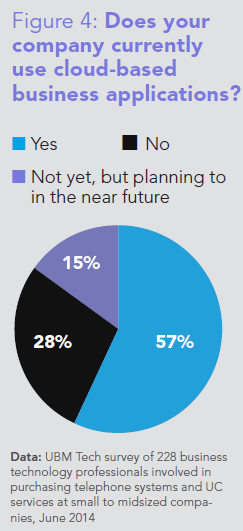
Nearly half (49%) of those surveyed reported that they are familiar, quite familiar, or very familiar with cloud-based virtual PBX or hosted phone systems (see Figure 5).

At the same time, 23% characterized their familiarity as neutral, and 27% reported limited familiarity with cloud-based virtual PBX or hosted phone systems.
Respondents to the UBM Tech survey consider the following to be the top advantages of a virtual PBX service versus a traditional phone system:
- Reduced communications costs
- Ability to access critical business applications from anywhere
- Increased scalability and flexibility
- Improved employee productivity
- Enhanced support for mobile workers and devices
This indicates that the companies surveyed have a healthy level of awareness of cloud-based virtual PBX advantages (see Figure 6). These respondents are also aware that a mobile smartphone app can be used to extend benefits so the workforce is fully connected anytime, anywhere. The added benefits of unified communications features and HD-quality phone service can make this option even more compelling.
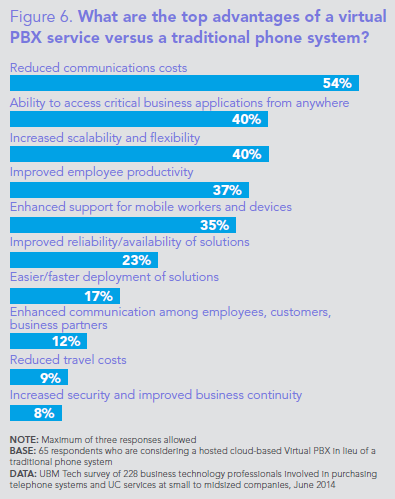
The top three advantages respondents cited for having unified communications functionality hosted in the cloud, according to the research, include better support for remote and mobile workers, easier-to-manage collaboration features, and enhanced disaster recovery (see Figure 7).
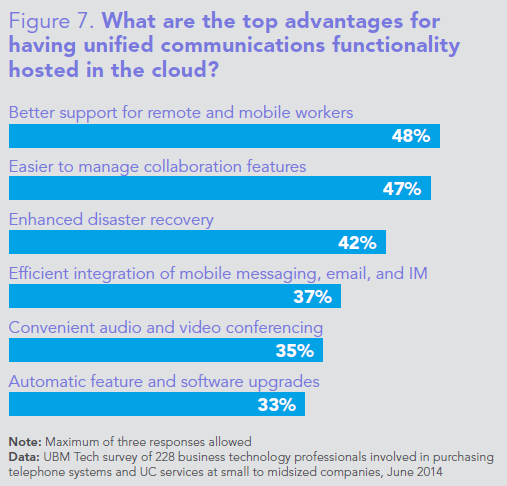
More than half (54%) of respondents indicated it is very important that a solution include a complete package, including hosted PBX services, unified communications, and state-of-the-art phones with high-definition audio quality with video options (see Figure 8).
Barriers to Adoption
Only 10% of survey respondents reported that their companies would not consider an alternative to traditional PBX or key systems. Some have already evaluated these alternatives and determined they do not meet their needs, while others prefer to use a traditional PBX or key system that has met their needs in the past.
Twenty-seven percent of those who indicated they would not consider alternatives to traditional phone systems said the primary reason is that they are not familiar enough to select a cloud-based virtual PBX or communications solution, while 17% say they are still in the early stages of their cloud strategy, and another 17% are not convinced about real cost savings associated with cloud-based communications.
Respondents to the UBM Tech survey demonstrated a general awareness and relatively high level of acceptance of fully managed cloud-based telephone and unified communications services.
These respondents recognize the potential economic value of a virtual service alternative to traditional PBX or key systems that allows them to reduce their capital expenditure on expensive phone system hardware, while saving on maintenance, unlimited nationwide calling, and free on-net calling where monthly costs will be predictable. They also value a simple, powerful, and scalable communications solution that will grow with them, with most feature functions in the network.
But respondents also identified certain barriers to adoption and challenges in implementation, including:
- Not being convinced about the real cost savings associated with cloud-based communications
- Requirements that their organizations retain direct control over voice and unified communications
- Concerns about security, privacy, and regulatory compliance
In order to drive adoption beyond the first wave of early adopters, these concerns must be addressed and a financial model must be created to demonstrate the savings in total cost of ownership over a 5- to 10-year period.
Interested in learning about voice solutions from Comcast Business? Visit http://business.comcast.com/phone
As the nature and location of work has changed over the past several years, organizations are increasingly seeking flexible communications.
Locked Content
Click on the button below to get access
Unlock NowOr sign in to access all content on Comcast Business Community
Tags
Resource Center
Learn how Comcast Business can help
keep you ready for what's next.










